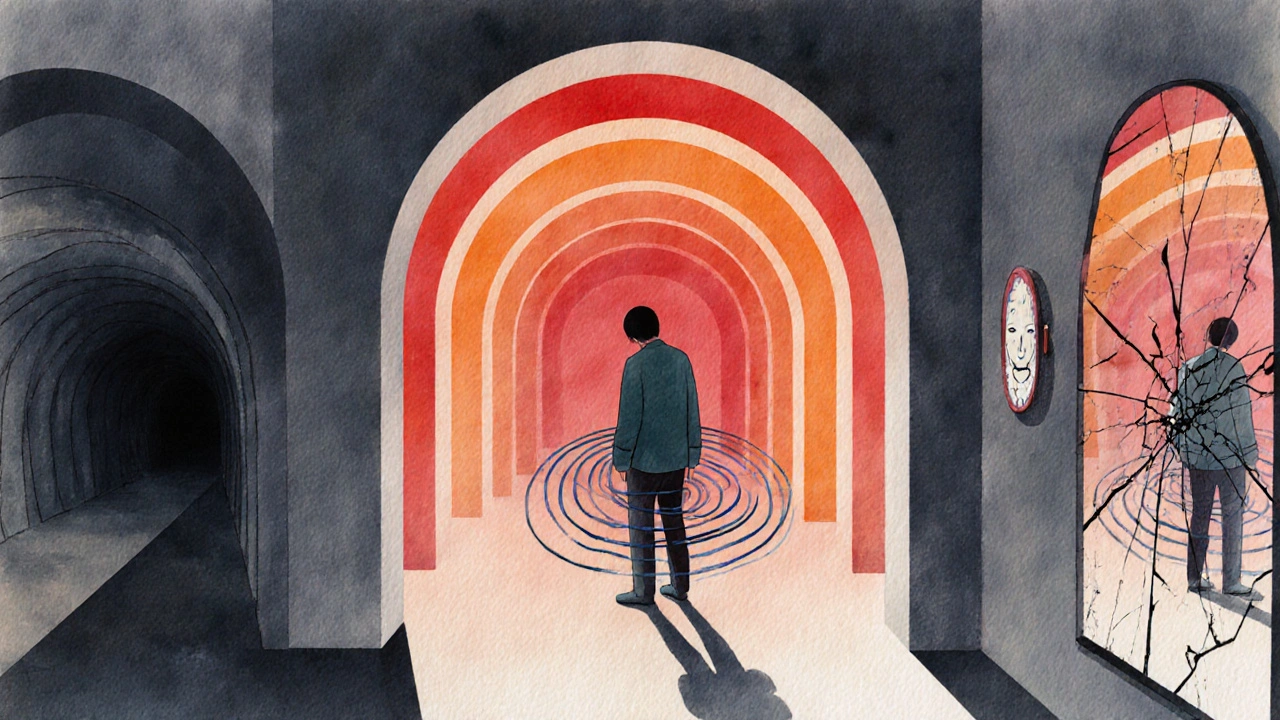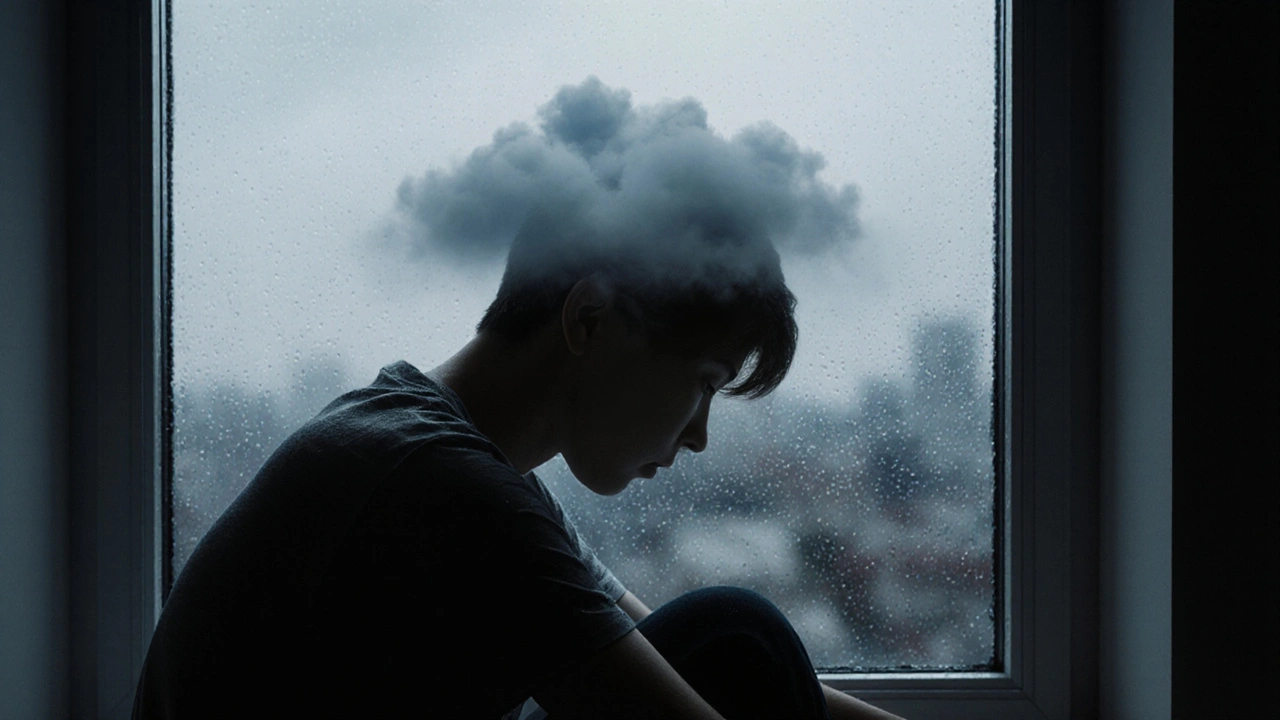Depression Symptom & Suicidal Thought Awareness Checker
This tool helps identify symptom clusters most strongly associated with suicidal thoughts based on clinical research. It is not a diagnostic tool, but rather an educational resource to help recognize warning signs.
Based on the symptoms you selected, this analysis shows which symptom clusters most closely correlate with suicidal thoughts according to clinical research.
Next Steps
If these symptoms persist or if someone you know is experiencing suicidal thoughts, please take these steps:
- Ask directly: Ask if they're thinking about harming themselves. Studies show asking does not increase risk.
- Ensure safety: Remove access to means like firearms, sharp objects, or large quantities of medication.
- Call emergency services: In the U.S., call 988 (Suicide & Crisis Lifeline) or 911 for immediate help. Find international resources
When someone feels trapped in a cloud of low mood, the line between everyday sadness and dangerous thoughts can get blurry. Understanding exactly how depression symptoms are the emotional, cognitive, and physical signs that signal a major depressive episode connect to suicidal thoughts are intrusive ideas about ending one’s own life, ranging from fleeting wishes to detailed plans helps you spot warning signs early and act before a crisis erupts.
Key Takeaways
- Core depression symptoms like hopelessness, anhedonia, and persistent sadness often precede suicidal thoughts.
- Not all people with depression think about suicide, but certain symptom patterns raise the risk dramatically.
- Recognizing warning signs-such as sudden mood shifts, talking about death, or giving away possessions-allows timely intervention.
- Professional help, a solid support network, and safety planning are the most effective ways to reduce risk.
- Immediate crisis resources (e.g., suicide hotlines) can save lives within minutes.
What Counts as Depression Symptoms?
Depression isn’t just feeling sad for a day or two. According to the DSM‑5, a full depressive episode includes at least five of the following for two weeks or more:
- Persistent low mood or emptiness.
- Loss of interest or pleasure in almost all activities (anhedonia the inability to feel joy or satisfaction).
- Significant changes in appetite or weight.
- Sleep disturbances-insomnia or hypersomnia.
- Fatigue or loss of energy.
- Feelings of worthlessness or excessive guilt.
- Difficulty concentrating, making decisions, or remembering.
- Psychomotor agitation or retardation.
- Recurrent thoughts of death or suicidal ideation.
Notice that the last item already mentions suicidal thoughts, underscoring how intertwined the two can be.
Understanding Suicidal Thoughts
Suicidal thoughts exist on a spectrum:
- Passive ideation - “I wish I weren’t here.”
- Active ideation without plan - “I keep thinking about ending it.”
- Active ideation with specific method or timeline - the highest risk state.
These thoughts often arise when a person feels that relief is impossible and that their pain outweighs any hope. The mental state of hopelessness a conviction that the future will not improve is a critical bridge between depressive mood and suicidal intent.

How Specific Symptoms Drive Suicidal Thoughts
Not every symptom carries the same risk. Research from 2023‑2024 shows that three clusters most strongly predict suicidal ideation:
- Hopelessness - When the brain can’t see any light, the mind may start looking for an “escape” route.
- Psychomotor agitation - Restlessness, irritability, or furious pacing can turn into impulsive attempts.
- Feelings of worthlessness - Believing you are a burden often fuels the notion that removing yourself would help others.
These clusters often coexist with anxiety (anxiety a heightened state of nervousness and fear that can amplify depressive distress) and can push a person from passive ideation to active planning.
Warning Signs to Watch For
Family, friends, and coworkers should stay alert for both verbal and behavioral cues. The following list merges clinical indicators with everyday observations:
- Talking about feeling trapped, burdensome, or a “better world” without them.
- Expressing sudden calm after a period of agitation-often a sign a decision has been made.
- Giving away prized possessions, canceling events, or writing goodbye notes.
- Increased alcohol or drug use, which can lower inhibitions.
- Self‑harm behaviors like cutting, burning, or reckless driving.
- Withdrawing from social circles, neglecting personal hygiene, or dropping responsibilities.
When any of these appear alongside a cluster of depression symptoms, treat the situation as an emergency.
Immediate Steps to Take
- Ask directly. Use a calm, non‑judgmental tone: “Are you thinking about harming yourself?” Studies show asking does not increase risk.
- Ensure safety. Remove access to firearms, sharp objects, or large quantities of medication.
- Engage professional help. Call a mental‑health crisis line (suicide helpline a 24/7 service that connects callers with trained counselors) or guide the person to the nearest emergency department.
- Provide emotional support. Listen, validate feelings, and avoid dismissive statements like “It’s just a phase.”
- Develop a safety plan. Write down warning signs, coping strategies, supportive contacts, and emergency numbers.
- Follow up. Check in regularly over the next days and weeks; sustained support reduces relapse.
Long‑term treatment options include psychotherapy (especially cognitive‑behavioral therapy and dialectical behavior therapy), medication such as SSRIs, and lifestyle changes like regular exercise and sleep hygiene.

Comparison: Depression Symptoms vs Suicidal Ideation Indicators
| Feature | Depression Symptoms | Suicidal Ideation Indicators |
|---|---|---|
| Emotional tone | Persistent sadness, emptiness | Feelings of hopelessness, desire to die |
| Cognitive changes | Difficulty concentrating, indecisiveness | Preoccupation with death, planning details |
| Behavioral signs | Social withdrawal, loss of interest | Giving away belongings, self‑harm, sudden calm |
| Physical symptoms | Sleep/appetite disturbances, fatigue | May include agitation, reckless actions |
| Risk level | Moderate‑high, varies by severity | High when specific plan or means exist |
Building a Supportive Environment
Beyond crisis response, fostering a community that reduces stigma makes a huge difference. Encourage open conversations about mental health at work, schools, and home. Provide resources such as pamphlets from trusted organizations, and train staff in basic mental‑health first aid.
For families, learning the basics of therapy a structured treatment with a mental‑health professional that can include talk therapy, medication management, or both helps you know when to suggest professional help and how to support ongoing treatment.
Frequently Asked Questions
Can someone with mild depression still have suicidal thoughts?
Yes. Even mild depressive episodes can include passive suicidal ideation, especially if hopelessness is present. It’s crucial to take any mention of death seriously, regardless of severity.
What is the fastest way to get help for someone in immediate danger?
Call emergency services (e.g., 911 in the U.S.) or a local suicide helpline right away. Stay with the person until help arrives, and remove any means of self‑harm.
How long does it usually take for therapy to reduce suicidal thoughts?
Short‑term gains can appear within a few weeks of evidence‑based therapy, but sustained reduction often requires ongoing sessions for several months, combined with medication if prescribed.
Are there any warning signs that appear only in teenagers?
Teens may show increased screen time, sudden drop in grades, or a new fascination with dark music and imagery. They might also start self‑harm behaviors as a way to cope.
Can medication alone prevent suicide?
Medication can lower depressive severity and reduce intrusive thoughts, but it works best when paired with therapy and a strong support network. Regular monitoring is essential.

Mark Anderson
October 12, 2025 AT 07:24Navigating the tangled web of depression and suicidal thoughts can feel like wandering through a stormy night, but there’s always a lighthouse on the horizon. When hopelessness settles in, it’s crucial to shine a bright, compassionate beam on the person’s inner world, reminding them that the darkness isn’t permanent. Building a safety net of trusted friends, regular check‑ins, and professional help can transform a fragile moment into a rescue operation. Encourage small victories-like getting out of bed or sharing a joke-because they stitch together the torn fabric of hope. Remember, every step forward, no matter how tiny, adds color back to the canvas of life.
Shouvik Mukherjee
October 30, 2025 AT 05:00Understanding cultural nuances can deepen our empathy for those battling depressive symptoms. In many communities, talking about mental health is still shrouded in stigma, so offering a listening ear without judgment creates a safe space. Encourage the person to seek professional guidance while also staying present as a steady companion. Simple gestures-like sharing a meal or a quiet walk-can bridge the gap between isolation and connection.
Ben Hooper
November 17, 2025 AT 02:36Mark highlighted the importance of hope and support. I agree that small victories matter a lot